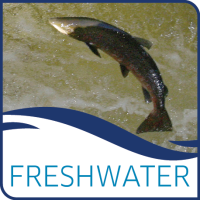These data underpin Figure 3, Table 3 and Appendix B of Willem B. Buddendorf, Faye L. Jackson, Iain A. Malcolm, Karen J. Millidine, Josie Geris, Mark E. Wilkinson, Chris Soulsby, Integration of juvenile habitat quality and river connectivity models to understand and prioritise the management of barriers for Atlantic salmon populations across spatial scales. STOTEN (2019), 655, 557-566 https://doi.org/10.1016/j.scitotenv.2018.11.263 The data show the increase in river connectivity that would result from the removal of impassable manmade barriers (IMBS) and thus provides a basis for assessing the impact of barriers on Atlantic salmon and the potential benefits of barrier removal / easement. By ranking the connectivity scores it has been possible to develop an aproach for prioritising management action. The connectivity metric "Delta DCIScot(%)" is the percentage increase in national connectivity that is obtained where a barrier is removed, assuming all barriers downstream have also been removed. Cumulative gain is the potential gain in delta DCIScot if this barrier and all downstream IMBs are removed; if there are no IMBs downstream then cumulative gain is equal to delta DCIScot. The connectivity metric used here is weighted by predicted salmon fry density obtained from the benchmark model presented by Iain A. Malcolm, Karen J. Millidine, Ross S. Glover, Faye L. Jackson, Colin P. Millar, Robert J. Fryer (2019) Development of a large-scale juvenile density model to inform the assessment and management of Atlantic salmon (Salmo salar) populations in Scotland, Ecological Indicators, Volume 96, Part 1, 2019, Pages 303-316. This contrasts with other approaches where the weighting is based on wetted areas or river length.
Data and Resources
- Habitat ranking of impassable mand-made barriers to fish migrationcsv
Unique catchment identifier - the SEPA catchment code (unique) and SEPA...
Preview Download
| Field | Value |
|---|---|
| Publisher | |
| Modified | 2020-01-07 |
| Release Date | 2018-11-28 |
| Identifier | cbddd853-364b-4bbd-aa20-f968680bdb89 |
| Spatial / Geographical Coverage Location | Scotland |
| License | UK Open Government Licence (OGL) |
| Author | |
| Data Dictionary | The passability of barriers was informed by the Scottish Obstacles to Fish Migration data set (see: https://www.sepa.org.uk/environment/environmental-data/). The dataset contains information on the location of barriers on the river network, whether they are natural or manmade and whether they are impassable or passable under certain conditions. All analyses were performed on a topologically corrected version of the Centre for Ecology and Hydrology (CEH) digital river network (hereafter DRN). Atlantic salmon fry densities were predicted for each river segment using landscape covariates (upstream catchment area (UCA), river distance to sea, and altitude) and the national juvenile salmon density model for Scotland developed by Malcolm et al. (2019). Given the focus on a diadromous species, the Dendritic Connectivity Index (DCI) was used to assess the impacts of barriers on longitudinal connectivity (Cote et al. 2009). Where values returned are between 0 – 100%. A value of 100% would be in a river network with no barriers, where all potential habitat (i.e., rivers below natural impassable barriers) is accessible from the outflow. The increase in connectivity associated with barrier removal was recorded as delta DCIScot. This indicates the percentage increase in connectivity at a national level and thus provides a basis for ranking and prioritising the removal or easing of barriers to migration based on environmental gain at both local and national scales. Delta DCIScot assumes all downstream IMBs are also removed. Cumulative gain is calculated by summing the Delta DCIScot of the barrier of interest with the ?DCIScot of downstream IMBs. |
| Contact Name | Marine Scotland |
| Contact Email | |
| Public Access Level | Public |


